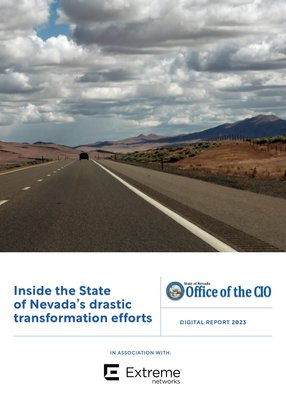Inside the State of Nevada’s drastic transformation efforts
Thanks to its geographical diversity, Nevada is an incredibly unique state in the context of the US. Its buzzing metropolitan areas, such as Las Vegas, are some of the largest and busiest in the country, but on the flip side its rural areas are vast, sparsely populated and often difficult to reach.
This presents a host of challenges for the State of Nevada, the government administration whose responsibility it is to ensure critical services are delivered to citizens across the area in an efficient fashion.
Those services include pretty much everything from the Department of Health and Human Services delivering supportive care to the Department of Motor Vehicles (DMV) dealing with licensing and vehicle registration.
“We have the Reno-Sparks metropolitan area including Carson City, where we’re based, then we have Vegas, and then we have this huge number of rural communities in between,” explains Timothy Galluzi, CIO at the State of Nevada.
“As the state government, we're responsible for delivering services to all residents – not just the ones living close to our offices.
“The services we deliver are not necessarily unique to Nevada, but the geography of our state and the location of our population centres definitely creates some unique challenges in the way we have to deliver them.”
Emphasising the State of Nevada’s core mission, Galluzi adds: “The residents of this state have put great trust in us to provide these services for them at significant investment. So, we need to be there for them whenever they need us, however they need us.”
The growing influence of technology
Plenty has changed within the State of Nevada since Galluzi first joined the organisation in 2017.
During the last legislative session, a governmental modernisation bill moved the enterprise IT services division – of which Galluzi was administrator – out of the Department of Administration and into the office of the governor, elevating it to cabinet level.
This not only gave the division a seat at the top table, but demonstrated its undeniable and ever-growing importance in the context of the modern-day state government.
“This means we’re now involved in cabinet meetings and having conversations with agency directors at a strategic level to figure out what their core business needs and challenges are – and we can be that voice to tell them how technology can help them on their path,” continues Galluzi.
“We’re moving beyond being an operational break/fix type of division to an area where we’re taking strategic leadership roles and helping to support the delivery of services.
“What we’re here to do is advise, and talk about the capabilities and limitations of technology. We can’t really talk about business needs and outcomes without technology being in the room, because technology is how we’re delivering a lot of that work.”
Becoming a ‘smart state’
Undoubtedly, one of the State of Nevada’s key strategic aims is to become a ‘smart state’. Central to this effort is an expansive programme of digital transformation which has the potential to impact all residents and enhance their lives.
“The concept of becoming a smart state leans on the fact we need to create easy ways for Nevadans to request and receive services,” says Galluzi.
Nevada’s geographic dispersion means that, from the IT chief’s perspective, this means ensuring the vast majority of the state’s services are available online and can be accessed via all browsers and devices.
Becoming ‘smart’ also relates to the state being more proactive in its service delivery.
Galluzi admits one of his long-term, visionary goals is to build up a detailed constituent identity for each individual, consisting of pretty much everything from basic information like their address to the services they are regularly consuming.
He explains: “That will get us to a point where we're not waiting on the constituent to reach out to us, so we can start delivering services more proactively.”
There are already “pockets of brilliance” within the state working towards this goal, such as the DMV which is undertaking a substantial digital transformation to move the vast majority of services from offices to web platforms and apps.
“Constituents won’t have to wait in line anymore, saving them time and saving the DMV overhead costs,” Galluzi continues.
“Let’s be frank: we have to be more efficient and effective in how we deliver services. Right now, we are seeing a massive vacancy rate in state government and it isn’t unique to Nevada.”
State of Nevada: A truly modern organisation
In keeping with the theme of digital transformation, the State of Nevada is going through a process of modernisation in various facets, including by harnessing the power of the cloud.
The government has adopted a sensible policy of being “cloud smart” – in other words, assessing options on a case-by-case basis and moving to the cloud when it makes sense. “Cloud is as much a part of technology as the internet,” contends Galluzi. “It’s simply a component piece now.
“If we're looking for a new product or a new service, one of the first places we look is at our SaaS vendors. In Nevada, whether it’s state-wide ERP, digital transformation efforts or our department of public safety's modernisation efforts, a lot of that is moving to SaaS-type platforms.”
Nevada also has a state private cloud, referred to as the Silver Cloud, which is being promoted as an option.
Summarising, Galluzi says: “What we’re really looking at is being cloud smart and leveraging our hybrid cloud environment.”
Meanwhile, Nevada’s wireless network infrastructure – because of its unique geography – is critical for the delivery of backhaul communications for some of the most remote sites in the state.
Over the past couple of years, the Department of Transportation has been working on improvements to the Nevada Shared Radio System, while significant investment has come through the ARPA grant programme to refresh microwave infrastructure from analogue to digital.
“We're really excited that we can use this funding to really leverage that capital expenditure to help our agencies reduce rates,” Galluzi goes on. “I know it doesn't sound very sexy, but that microwave refresh is huge because it will ensure stability in that environment for at least the next decade.
“The primary users are generally law enforcement officers who, when they hit that radio, need to have confidence that someone’s at the other end. It’s a system that needs to work.”
A brave new world
Thanks to major global events and game-changing new technologies, the world has changed – and is changing – like never before.
Organisations have been forced to adapt at breakneck speed and technology experts like Galluzi left with little choice but to think on their feet in a desperate bid to come up with solutions.
Of course, one of the most obvious everyday changes brought about by COVID-19 was the new age of remote working which, for the State of Nevada, has proved hugely beneficial.
“This massive proliferation of tools like Zoom and Teams has really raised the level of collaboration,” reveals Galluzi.
“I think we've raised our level of maturity so that, instead of everybody compiling work and having to bring it back into the office for processing or uploading, we’re ensuring our folks out in the field can still access the same level of technological support.”
Aforementioned staffing issues mean workflow automation is another weapon in the armoury which is fast becoming crucial to the State of Nevada.
In all departments, efficiency is key, hence the increasing prevalence of emerging technologies like generative AI.
Galluzi says: “If a repeatable task can be handled using an algorithm, AI or machine learning, it enables staff members to be utilised where they're more valuable. We can use our people for creative thinking and decision making, and let the computers do the routine, monotonous tasks.”
The importance of partnerships
The State of Nevada is regularly able to call upon a host of trusted partners in order to achieve its ambitions.
One is Extreme Networks, which has been a critical part of Nevada’s Department of Transportation infrastructure for some time, and is part of a recently-launched pilot in the central IT organisation.
“We're really excited about any opportunity that we can get to create a more resilient, reliable infrastructure,” continues Galluzi.
“Partners like Extreme Networks can really bring to the table capabilities like mesh networking, software-defined networking and microsegmentation to help ensure our infrastructure is there when we need it, and we’re really excited to have them on board within our technology portfolio.”
Galluzi is unequivocal about the importance of the partner community, and readily admits the state government would be lost were it not able to call upon a diverse range of vendors.
However, he insists prospective new vendors must quickly grasp the State of Nevada’s needs.
“One of the questions I’m often asked is, ‘what's the best way to do business with the state?’,” he concludes. “The key is understanding what our needs are, understanding where we're challenged and coming to me with a solution to a problem. Then we can start a conversation.”






